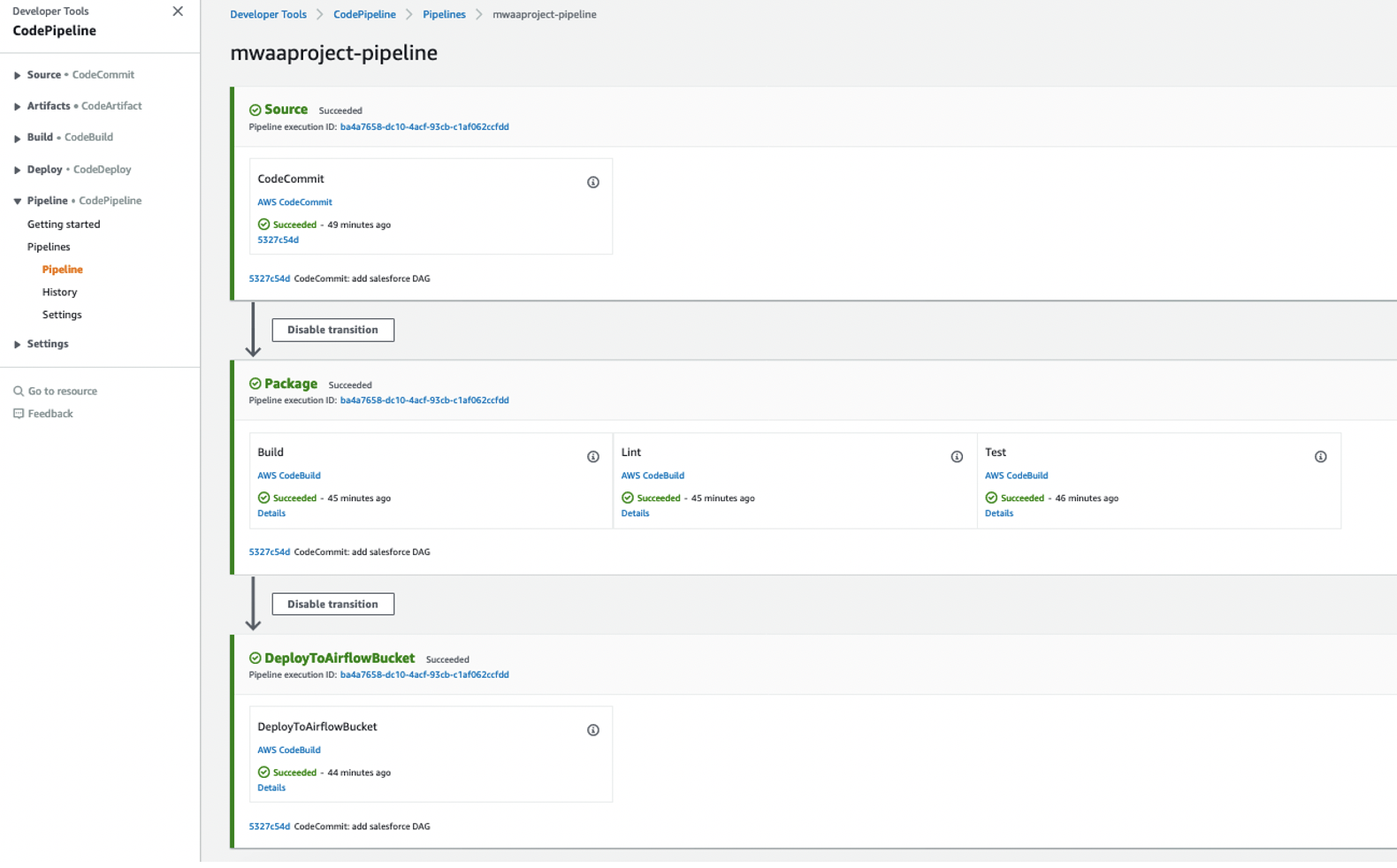The purpose of this solution is to automate the deployment and configuration of Managed Apache Airflow environments to programmatically author, schedule and monitor workflows.
This solution includes two CI/CD pipelines:
- The provisioning CI/CD Pipeline helps the MWAA Admins teams to:
- Automate MWAA environments deployment
- Automate Plugins and Requirements management for MWAA deployed environments
- The project CI/CD Pipeline helps the MWAA Users teams to:
- Start a python project with builtin DevOps best practices
- Continuously integrate and deploy their code and DAGs
- Prepare an AWS account (https://aws.amazon.com/premiumsupport/knowledge-center/create-and-activate-aws-account/) to be used for the installation
- Install the AWS Cloud Development Kit (https://aws.amazon.com/cdk/)
- Prepare Python 3.7 or newer environment
By default, the stack deploys a basic MWAA environment with the associated pipelines described previously. It will create a new VPC in order to host the MWAA resources. The stack can be customized using the following parameters. To pass a paramater you should use the following command:
cdk deploy -c paramName=paramValue| Parameter | Description | Default | Valid values |
|---|---|---|---|
| vpcId | VPC ID where the cluster will be deployed. If none creates a new one and needs the parameter cidr in that case | None | VPC ID |
| cidr | The cidr for the VPC that will be created to host MWAA resources. Used only if the vpcId is not defined. | 172.31.0.0/16 | IP CIDR |
| subnetIds | Comma separated list of subnets IDs where the cluster will be deployed. If None looks for private subnets in the same AZ | None | Subnet IDs list (coma separated) |
| envName | MWAA Environment Name | MwaaEnvironment | String |
| envTags | MWAA Environment Tags | None | json ex. '{"Environment":"MyEnv","Application":"MyApp","Reason":"Airflow"}' |
| environmentClass | MWAA Environment Class | mw1.small | mw1.small, mw1.medium, mw1.large |
| maxWorkers | MWAA Max Workers | 1 | int |
| webserverAccessMode | MWAA Environment Access mode (private/public) | PUBLIC_ONLY | PUBLIC_ONLY, PRIVATE_ONLY |
| secretsBackend | MWAA Environment Secrets Backend | Airflow | Airflow, SecretsManager |
-
Before using AWS CDK you need to bootstrap your AWS account following the AWS guide here: https://docs.aws.amazon.com/cdk/latest/guide/bootstrapping.html Quick command:
cdk bootstrap aws://YOUR_ACCOUNT_ID/YOUR_REGION
-
Define CDK environment variables
On Linux or MacOSexport CDK_DEFAULT_ACCOUNT=YOUR_ACCOUNT_ID export CDK_DEFAULT_REGION=YOUR_REGION
On Windows
setx CDK_DEFAULT_ACCOUNT YOUR_ACCOUNT_ID setx CDK_DEFAULT_REGION YOUR_REGION
-
Launch the Stack
Replace the<YOUR_VPC_ID>with your VPC ID or refer to the parameters description to create a new VPC by passing acidrparameter and run the following command:cd mwaairflow && \ pip install . && \ cdk synth && \ cdk deploy -c vpcId=<YOUR_VPC_ID>
This solution deploys a tutorial DAG for your teams to get started !

As part of the CDK deployment, an AWS CodeCommit and an AWS CodePipeline were created in order to continuously build, test and deploy DAGs into your MWAA environment. To deploy the new DAG, the source code should be committed to the CodeCommit repository. This will trigger a CodePipeline run that will build, test and deploy your new DAG and make it available in your MWAA environment. To do so, follow the steps below:
- Login to the CodeCommit console in your deployment region.
- Under Source > Repositories you should see a new repository mwaaproject.

- Push your new DAG in mwaaproject repository under dags. You can either use the CodeCommit console or Git command-line to do so.

- The new commit triggers a new CodePipeline that will build, test and deploy the new DAG. To the check the Pipeline execution login to CodePipeline console. Under Pipeline > Pipelines you should see mwaaproject-pipeline.

- Click on mwaaproject-pipeline name to display its details.

- After checking that the pipeline run is successful, you can verify that the DAG is deployed to the S3 bucket and therefore available in MWAA Console.

To clean up the deployed resources, you can simply run the following command:
cdk destroyMake sure you are in the root path of the project when you run the command.
See CONTRIBUTING for more information.
This library is licensed under the MIT-0 License. See the LICENSE file.
